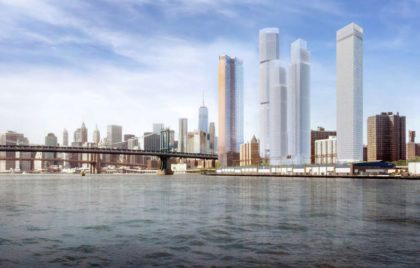Judge sends Two Bridges skyscrapers back to drawing board
Councilmember Margaret Chin, BP Gale Brewer and local residents have spent a good chunk of the past couple years fighting the mega monster supertalls planned for Two Bridges — and on Thursday they got some traction. A judge ruled that the city must put the project through the public review process — or ULURP — rather than let it fly through the city’s land use process as a “minor modification” to the zoning code. The council speaker and of course neighbors — who have rallied over this issue for three years — agreed.
The proposed buildings — being developed by JDS Development Group, L+M Development, CIM Group and Starrett Corporation at 247 Cherry St., 260 South St. and 259 Clinton St. — are 80 stories tall (1,000 feet!) with 2,800 units. Of those, 700 would have been affordable. Which gets us to the next question: as this process unfolds, either through ULURP or through a successful appeal by the developers, what will these buildings end up looking like? What is the best outcome for neighbors? The de Blasio administration chose affordable housing over height and that failed with neighbors. But assuming there is also a local need and want for affordable units, can that same number be preserved smaller buildings? Does the development end up looking completely different — in my mind it has to, since losing a story or two won’t make a difference — or do the developers throw in the towel?
This is what the judge said: “The irreparable harm here is two-fold. First, a community will be drastically altered without having had its proper say. Second, and arguably more important, allowing this project to proceed without the City Council’s imprimatur would distort the City’s carefully crafted system of checks and balances … Without ULURP, the City’s legislature is cut out of the picture entirely.”
The city was sued not just by Chin and Brewer, but also three community groups: the Lower East Side Organized Neighbors, the Chinese Staff and Workers Association and the Asian American Legal Defense Fund, who argued that the developments would threaten the character of the area.














